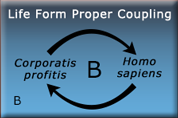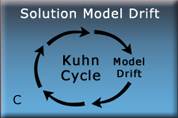Summary of Solution Elements
The key output of the analysis is the root causes and their high leverage points. The Solution Convergence step uses this knowledge to develop systemic solutions. A total of 12 sample solution element are listed in the last row of the table below.

The power of this approach is each solution element pushes on a high leverage point to resolve a specific root cause. A high leverage point is a place in a system's structure that requires relatively little force to have a large predictable beneficial effect.
There are nine solution elements for subproblem A but one solution element for each of the other subproblems. That's because overcoming change resistance is the crux of the problem. Here's why:
Of the four root causes, one is the deepest. The root cause of subproblem B causes the other three root causes. Corporatis profitis has the wrong goal of short term profit maximization. That wrong goal causes the corporate life form to use political deception (subproblem A) to resist any change that would threaten its dominance or reduce short term profits. The wrong goal leads to encouraging low quality of political decisions (subproblem C) and to high transaction costs for managing common property sustainably (subproblem D).
Thus the deepmost problem to solve is subproblem B, the wrong goal of large corporations. But to solve it we have to overcome change resistance first. The New Dominant Life Form is putting up a real fight. It's leading the charge against solving the environmental sustainability problem by controlling political systems. It uses money and deception to do that. Since large for-profit corporations have much, much more money, power, and a longer attention span than citizens, NGOs, politicians, academics, governments, and all other social agents, corporations are winning. Their dominance looks unassailable.
Until, of course, you analyze the system, find the root causes, find their high leverage points, and start pushing on them. This has never been done. That's why the solutions we are about to present (or ones like them) have a good chance of working.
How you can hit the bullseye
 Past solutions did not have the advantage of "seeing" where they were pushing on the structure of the system. These solutions do. An old saying is "You can't hit the bullseye if you don't know where the target is." The analysis tells you exactly where the target is. The root cause is the bullseye. There are four targets, one for each subproblem. Your solutions aim for the high leverage points. By doing so they hit the bullseyes, which are the root causes. This gives us high solution accuracy. Each solution element is like a rifle shot or an arrow fired up close at a known target. How can you miss?
Past solutions did not have the advantage of "seeing" where they were pushing on the structure of the system. These solutions do. An old saying is "You can't hit the bullseye if you don't know where the target is." The analysis tells you exactly where the target is. The root cause is the bullseye. There are four targets, one for each subproblem. Your solutions aim for the high leverage points. By doing so they hit the bullseyes, which are the root causes. This gives us high solution accuracy. Each solution element is like a rifle shot or an arrow fired up close at a known target. How can you miss?
Conversely, past solutions did not know where the target was, so how could they possibly hit the bullseye?
The solution elements here are not the solution. They are examples of a more productive way forward. Some may be useful.
Here are the subproblems and an overview of their solution elements.
Subproblem A
How to overcome change resistance
The high leverage point is raising general ability to detect political deception. We have to make people truth literate so they can't be so easily fooled by deceptive politicians, articles, television personalities, and so on. This subproblem is so hard to solve we developed nine sample solution elements:
1. Freedom from Falsehood
2. The Truth Test, also called Truth Literacy Training
3. Politician Decision Ratings
4. Politician Corruption Ratings
5. No Servant Secrets
6. Corporation 2.0 Suffix
7. Servant Responsibility Ratings
8. Sustainability Index
9. Quality of Life Index
The foundational solution element is Freedom from Falsehood. This is a new right people need to give themselves. It allows citizens to be able trust those they rely on to run their political system because they are no longer being lied to.
Several solution elements establish the feedback loops that will cause politicians to behave in a trustful manner: the Truth Test, Politician Decision Ratings, and Politician Corruption Ratings. But what about corporations? They need to be trustworthy too. For that we have No Servant Secrets, Corporation 2.0 Suffix, and Servant Responsibility Ratings. Finally, we need to consider how citizens can look at the system as a whole to determine how well politicians are doing, so they can't be deceived. For that we have the Sustainability Index and the Quality of Life Index. These replace stock market indexes and GDP growth as the true measures of how well politicians are doing in what matters most to people, rather than corporations.
Subproblem B
How to achieve life form proper coupling
The high leverage point is correctness of goals for artificial life forms. Since the one causing the problem right now is Corporatis profitis, this means we have to reengineer the modern corporation to have the right goal.
Corporations were never designed in a comprehensive manner to serve the people. They evolved. What we have today can be called Corporation 1.0. It serves itself. What we need instead is the solution element of Corporation 2.0. This life form is designed to serve people rather than itself. Its new role will be that of a trusted servant whose goal is providing the goods and services needed to optimize quality of life for people in a sustainable manner.
Subproblem C
How to avoid excessive model drift
What’s drifted too far is the decision making model that governments use to decide what to do. It’s incapable of solving the sustainability problem.
The high leverage point is to greatly improve the maturity of the political decision making process. Like Corporation 1.0, that process was never designed. It evolved. It’s thus not quite what we want. The solution element of Politician Decision Ratings works like this: Imagine what it would be like if politicians were rated on the quality of their decisions. They would start competing to see who could improve quality of life and the common good the most. That would lead to the most pleasant race to the top the world has ever seen.
Subproblem D
How to achieve environmental proper coupling
Presently the world’s economic system is improperly coupled to the environment. The high leverage point is allow new types of social agents to appear to radically reduce the cost of managing the sustainability problem.
This can be done with the solution element of Common Property Rights. This is a deep change to property rights law. It centers on a new type of firm: non-profit stewardship corporations. Each steward would have the goal of sustainably managing some portion of the sustainability problem. Like the way corporations charge prices for their goods and services, stewards would charge fees for ecosystem service use. The income goes to solving the problem.
Corporations gave us the Industrial Revolution. That revolution is flawed until stewards give us the Sustainability Revolution.






























